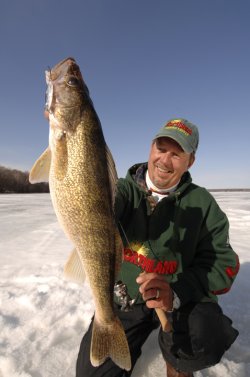
Walleyes through the ice tend to be classified as finicky and hard to catch. The reason for this “generalization” is that winter marble eyes get classified as just that, “inactive fish.” An angler’s mentality completely changes when the ice forms and they tend to look at ice walleyes totally different than in open water eyes. Remember that these are the same fish, just at a different time of year.
I sat down with Scott Glorvigen, 2004 PWT Championship, and 2000 FLW Championship winner, to discuss winter walleyes. He immediately brought up that walleyes don’t change in the winter. “They have seasonal movements and transitions just like open water walleyes, but people just assume they get hard to catch and become inactive,” Scott said.
Scott breaks the ice season into two seasons; early ice and late ice. The following is the approach he takes in breaking down the winter movements, locations, and techniques.
Early ice: Early season ice fishing for walleyes needs to be approached with the fall transition in mind. The fish are set up in deep water close to major structural elements in the fall. The fish haven’t moved off of this structure as the first ice sets in. The cisco and whitefish spawn is still tailing off for the season and the forage base is still present, which means the fish are still located in areas with deep water access close to shallow water, where the baitfish are finishing spawning. Scott focuses on flats that have points and sharp drop-offs with rock and gravel, adjacent to the main lake’s deep water.
Scott starts by drilling holes on the shallow edge (8-10 feet) of the drop-off and drills a line of holes to the deep edge (25-32 feet). The preferred technique is fairly aggressive jigging using a Northland Buck-Shot Rattle Spoon, or the new Macho Minnow, tipped with the head of the shiner minnow. Work the jig aggressively up and down with a short pause on the lift. Don’t spend a lot of time in each hole. This is a locating technique. Move through each hole till you locate where the eyes are. At this time, Scott will drill a second hole putting down a more subtle presentation (new Northland Lite-Bite Slip Bobber with a shiner) to get the less aggressive fish. As the evening light conditions start to set in, be ready to move up shallow as fish move up to the flats for the evening bite. The holes are already drilled, just follow the fish movement.
Late Ice: Late ice where Scott lives (Northern Minnesota) can run all the way into April. He looks for pre-spawn areas this time of year. Scott’s theory, “The walleyes already have spawn in mind. They are already starting their seasonal movements to set up spawning grounds. This is the key to locating walleyes in the late ice phase.”
Scott spends his time on the staging areas for spawning grounds, “Look for a connecting river, stream, or runoff, things that will be bringing in the warmest water. Shoreline structure is the answer this time of year; gravel shorelines, spawning sections where rivers and streams run in. Better yet, is to have a pressure ridge in this area, because pressure ridges create as much structure below the water as you see above the water. These areas hold the baitfish during the late ice phase.”
The main structural element Scott looks for this time of year is an inside turn close to known spawning grounds. This is where the fish will hold up before spawning starts. Look for these areas and drill holes the same as you would for early ice. Start by drilling in shallow water, drilling a line of holes to the deep end of the inside turn.
The technique for this time of year is dead sticking with live bait. “The fish are fairly lethargic, but still feeding this time of year. Jigging can be too aggressive. I like a Northland Eye-Ball Spoon tipped with a fathead minnow or a shiner. I just set it on my bucket and watch the rod tip, “comments Scott.
Electronics: “The tools available to the ice angler now are priceless,” Scott states, “With the combo units (GPS and Depth finder), and the maps available, the fisherman’s job just got easier. I can study the maps at home, pick out the proper locations to try, and drive right to them using the GPS. I can drill holes in precise locations fishing the spot on the spot.” Scott adds,” I wouldn’t be without combo electronics anymore. Because of the ease, it creates with fishing, the work it saves in locating fish, and the safety of knowing I can get off the ice if fog or a snowstorm moves in.”
There is no doubt that Scott is known as a walleye fanatic in the summer months. He’s made a living by doing it, but also he chases them just as hard in the winter. Scott is successful because he keeps seasonal movements in his arsenal, even when the water is rock hard.

